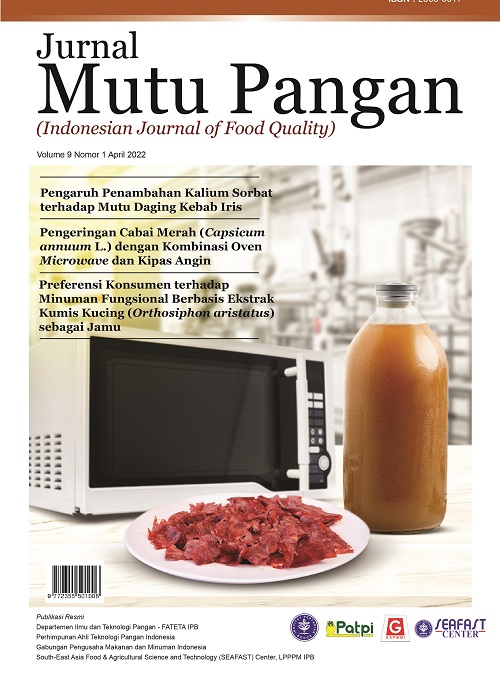Pengeringan Cabai Merah (Capsicum annuum L.) dengan Kombinasi Oven Microwave dan Kipas Angin
Abstract
This study was aimed to obtain the best drying method of red chilies (Capsicum annuum L.) using a combination of microwave and fan as well as the characteristics of the dried chilies. Samples were subjected to drying step I, equilibration, and drying step II. Each drying step consisted of heating in microwave followed by blowing with fan repeatedly. The treatment of drying step I were 90 seconds of heating followed by 3 minutes of blowing for 7 cycles and 120 seconds of heating followed by 4 minutes of blowing for 5 cycles. Equlibration was done for 1, 2, and 3 hours. The drying step II consisted of 60 seconds of heating followed by 2 minutes of blowing repeatedly until final moisture content of <10%. All samples were analyzed for their moisture content, color, and vitamin C. The drying rates tend to decrease slowly during drying step I but faster during drying step II. The L* and a* of all samples were not significantly different (p > 0.05). The vitamin C of samples ranged between 66.53-72.68 mg/100 g and significantly decreased with increasing equilibration time. The treatment resulting in the best quality product with shortest drying time was 120 seconds of heating followed by 4 minutes of blowing for 5 cycles, 1 hour of equilibration and 60 seconds of heating followed by 2 minutes of blowing for 10 cycles.
Downloads
References
[AOAC] Association of Official Analytical Chemist. 2012. Official Methods of Analysis of AOAC International, 19th edition. Washington DC (US): AOAC International.
[BPS] Badan Pusat Statistik. 2020. Distribusi Perdagangan Komoditas Cabai Merah Indonesia Tahun 2020. Jakarta (ID): Badan Pusat Statistik RI.
Arslan A, Soysal Y, Keskin M. 2020. Mathematical modeling, moisture diffusion, and color quality in intermittent microwave drying of organic and conventional sweet red peppers. AgriEngineering 2(3): 393-407. DOI: 10.3390/agriengineering2030027.
Asmal A. 2018. Analisis kandungan vitamin C dalam cabai rawit (Capsicum fructuscens L.) secara iodimetri. J Farmasi Sandi Karsa 4(7): 99-103.
Arimboor R, Natarajan RB, Menon KR, Chandrasekhar LP, Moorkoth V. 2015. Red pepper (Capsicum annuum) carotenoids as a source of natural food colors: Analysis and stability-a review. J Food Sci Technol 52(2015): 1258-1271. DOI: 10.1007/s13197-014-1260-7.
Dendang N, Lahming, Rais M. 2016. Pengaruh lama dan suhu pengeringan terhadap mutu bubuk cabai merah (Capsicum annum L.) dengan menggunakan cabinet dryer. J Pendidikan Teknologi Pertanian 2: 30-39.
Feng H, Yin Y, Tang J. 2012. Microwave drying of food and agricultural materials: basics and heat and mass transfer modeling. Food Eng Rev 4(2): 89-106. DOI: 10.1007/s12393-012-9048-x.
Firdaus A. 2016. Perancangan dan analisa alat pengering ikan dengan memanfaatkan energi briket batubara. J Teknik Mesin 5(4): 128-136. DOI: 10.22441/jtm.v5i4.1216.
Gunal H, Ersahin S, Yetgin B, Kutlu T. 2008. Use of chromameter-measured color parameters in estimating color-related soil variables. Commun Soil Sci Plant Anal 39(5-6): 726-740. DOI: 10.1080/00103620701879422.
Gunawan K. 2016. Aplikasi Trehalose pada Pengeringan Cabai Merah (Capsicum annum L.) untuk Memperbaiki Karakteristik Rehidrasi Cabai Merah Kering. [Skripsi]. Bogor: Institut Pertanian Bogor.
Horuz E, Bozkurt H, Karatas H, Maskan M. 2020. Microwave-conventional drying characteristics of red pepper: Modeling, temperature profile, diffusivity and activation energy. J Agric Sci Technol 22(2): 425-437.
Mahmud MK, Hermana, Zulfianto NA, Apriyantono RR, Ngadiarti I, Hartati B, Bernadus, Tinexcelly. 2009. Tabel Komposisi Pangan Indonesia. Elex Media Komputindo, Jakarta.
Mikasari W. 2016. Peningkatan nilai tambah komoditas cabai melalui penerapan inovasi penyimpanan dan pengeringan di Provinsi Bengkulu. [Laporan Akhir Tahun]. Bengkulu: Badan Pengkajian Teknologi Pertanian Bengkulu.
Nauly D. 2016. Fluktuasi dan disparitas harga cabai di Indonesia. J Agrosains Teknologi 1(1): 56-69.
Okeke C, Abioye AE, Omosun Y. 2014. Microwave heating applications in food processing. J Electrical Electronics Eng 9(4): 29-34. DOI: 10.9790/1676-09422934.
Parfiyanti EA, Budihastuti R, Hastuti ED. 2016. Pengaruh suhu pengeringan yang berbeda terhadap kualitas cabai rawit (Capsicum frutescens L.). J Biologi 5(1): 82-92.
Pinar H, Çetin N, Ciftci B, Karaman K, Kaplan M. 2021. Biochemical composition, drying kinetics and chromatic parameters of red pepper as affected by cultivars and drying methods. J Food Compos Anal 102(2021): 103976. DOI: 10.1016/j.jfca.2021.103976.
Ramdani H, Wicaksono RA, Fachruddin MA. 2018. Penambahan natrium metabisulfit (Na2S2O5) terhadap vitamin C dan warna pada proses pengeringan cabai merah (Capsicum annum L.) dengan tunnel dehydrator. J Agrinoda 4(2): 88-97. DOI: 10.30997/jag.v4i2.1572.
Wray D, Ramaswamy HS. 2015. Novel concepts in microwave drying of foods. Dry Technol 33(7): 769-783. DOI: 10.1080/07373937.2014.985793.

















